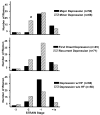A cross-sectional evaluation of perimenopausal depression
- PMID: 18505304
- PMCID: PMC2727626
- DOI: 10.4088/jcp.v69n0614
A cross-sectional evaluation of perimenopausal depression
Abstract
Objective: Overall, the clinical spectrum of depression during the perimenopause is not well characterized. This cross-sectional study examined the following: (1) clinical characteristics of women who presented to the National Institute of Mental Health midlife mood disorders clinic (between March 1990 and January 2004) with peri-menopausal major and minor depressions and (2) the impact on these characteristics of either a prior episode of depression or the presence of hot flushes.
Method: Historical variables, reproductive status, symptom ratings, and plasma hormone measures were examined in 116 women between the ages of 40 and 55 years who met research criteria for perimenopause-related depression (a current episode of major or minor depression according to the Structured Clinical Interview for DSM-IV or Primary Care Evaluation of Mental Disorders supplemented with a past history form).
Results: Clinical characteristics did not differ in those women with first-onset (39%) versus recurrent depressions or in those with (57%) and without hot flushes. Depressive episodes clustered in the later stages of the menopause transition and the first year postmenopause. Seven women (6%) reported a past postpartum major depression, and 55% of women reported a history of premenstrual dysphoria (PMD).
Conclusions: We found no evidence that either hot flushes or a previous episode of depression conveys a distinct clinical profile in these women. The clustering of onsets of depression suggests the hormone events that characterize the late menopause transition may be relevant to the onset of this form of depression. Finally, although we observed a high rate of PMD, neither postpartum depression nor PMD are consistent accompaniments of perimenopausal depression.
Figures

References
-
- Cohen LS, Soares CN, Vitonis AF, et al. Risk for new onset of depression during the menopausal transition. The Harvard study of moods and cycles. Arch Gen Psychiatry. 2006;63:385–390. - PubMed
-
- Freeman EW, Sammel MD, Lin H, et al. Associations of hormones and menopausal status with depressed mood in women with no history of depression. Arch Gen Psychiatry. 2006;63:375–382. - PubMed
-
- Bromberger JT, Assmann SF, Avis NE, et al. Persistent mood symptoms in a multiethnic community cohort of pre- and perimenopausal women. Am J Epidemiol. 2003;158:347–356. - PubMed
-
- Stearns V, Ullmer L, Lopez JF, et al. Hot flushes. Lancet. 2002;360:1851–1861. - PubMed
MeSH terms
Grants and funding
LinkOut - more resources
Full Text Sources
Medical
Miscellaneous

